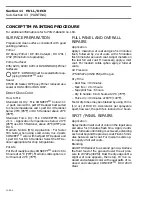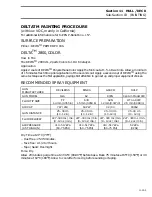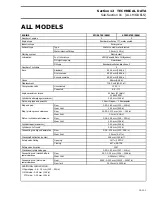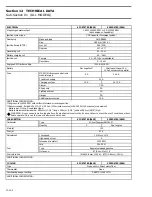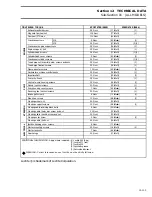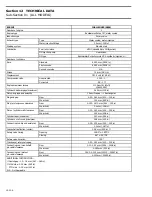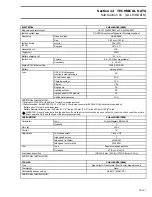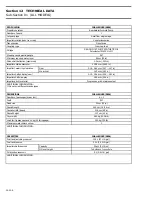
Section 11
HULL / DECK
Sub-Section 02
(REPAIR)
11-02-2
BLISTERS
Possible Causes
– Inert catalyst.
– Improper catalyst / gelcoat ratio.
A blister is a visible bump on the Sea-Doo jet boat
surface that may not necessarily come right
through the gelcoat layer. In the case of only a few
blisters, you may follow the same repair proce-
dure as for air bubbles. If they are numerous and
in close concentration, you may have to spray liq-
uid gelcoat to achieve proper repair. This proce-
dure is covered in the next problem.
CAUTION : Ensure blistered area is
com-
pletly
dry before attempting repairs.
MINOR GELCOAT FRACTURES
Possible Causes
– Flexing of fiberglass laminate.
– Gelcoat thickness.
– Direct result of impact.
In case of fractures which have not penetrated
past the gelcoat layer, the repair concerns the
gelcoat only. If flex cracking or impact are evident,
then additional reinforcement may be necessary.
This subject will be covered in the next problem.
1) Preparing the Surfaces
Small Fractures :
Open the cracks up with a sharp triangular can
opener or preferably a carbide tipped die grinder.
The V groove will provide a good bonding area for
the gelcoat. With 220-grit sandpaper, sand the
sides of the notched out areas.
Numerous Fractures :
Using a grinder with a 24-grit disk, remove the
gelcoat. Sand the area edge with 220-grit sandpa-
per.
2) Filling the Repair Area
Small Fractures :
Refer to the same procedure as in the air bubbles.
Numerous Fractures Over Large Surface :
Prepare the area for spray application of liquid
gelcoat. Wipe down the surface with acetone.
Mask the area off to protect the boat from over-
spray.
Mix the needed quantity of gelcoat and catalyst
according to suppliers recommendations. The
gelcoat can be thinned with acetone up to 10%. If
it needs more consistency you can add cabosil.
Make sure that the air supply is free of oil, dirt and
water.
Test spray the gelcoat mixture on paper to verify
its consistency and pattern. You may have to ap-
ply 5 or 6 coats to cover the area properly. Overlap
each coat further than the last, leaving at least 30
seconds between passes. Avoid trying to coat the
surface with only a few heavy coats, this will not
allow the gelcoat to dry properly.
Apply a coat of polyvinyl alcohol to seal off the air
and protect the gelcoat surface from dust. PVA
speeds up the curing process because gelcoat
will not cure properly when exposed to air.
3) Sanding
Wash the polyvinyl alcohol off with water. De-
pending on the size of the area repaired, you can
either block sand as per previous procedure or
you may use an air sander. Sand the surface down
with progressively finer grits of sandpaper until
the desired finish is achieved.
4)Buffing and Waxing
Buff the surface using a heavy duty polisher with
a buffing pad. Make sure the pad is free of dirt or
you may damage the gelcoat. Carefully begin
buffing with a white medium compound RM 856.
Finish off using a fine RM 852 compound. While
buffing, pay close attention to avoid overheating
the surface.
COMPOUND FRACTURES
Possible Causes
– Thickness of fiberglass laminate.
– Direct result of impact.
-
Summary of Contents for Challenger 5896
Page 1: ......
Page 2: ......
Page 3: ...219 100 044 0 0 0 1996 Shop Manual 0 R ...
Page 152: ...Section 08 ELECTRICAL Sub Section 03 IGNITION SYSTEM 08 03 2 ELECTRICAL BOX Sportster F04H11S ...
Page 154: ...Section 08 ELECTRICAL Sub Section 03 IGNITION SYSTEM 08 03 4 ELECTRICAL BOX Speedster F04H26S ...
Page 251: ...Section 11 HULL DECK Sub Section 01 COMPONENTS 11 01 5 F04L3IS Loctite 242 ...
Page 274: ......





















